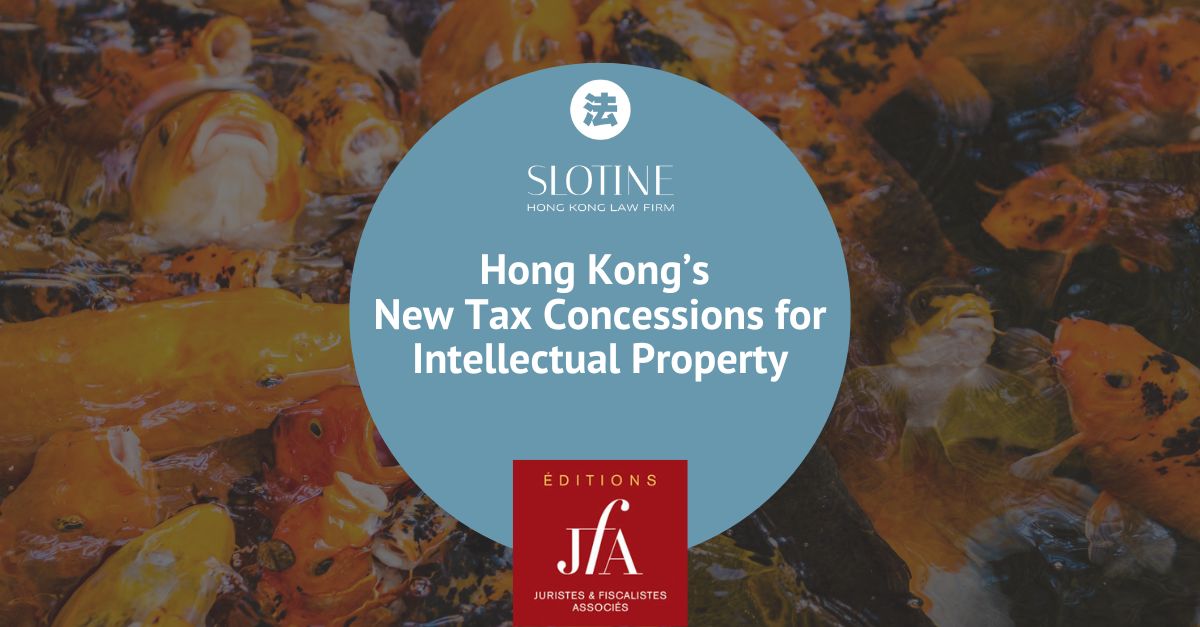Under the Inland Revenue (Amendment) (Tax Concessions for Intellectual Property Income) Ordinance 2024 enacted on 5 July 2024, Hong Kong has implemented a new concessionary patent tax regime (“patent box”), with tax reliefs for certain taxable profits arising from eligible intellectual property income. These incentives are applied retroactively from the 2023/2024 financial year. We present the main features of this tax incentive.
Inland Revenue (Amendment) (Tax Concessions for Intellectual Property Income) Ordinance 2024
Introduction of a concessionary tax rate – the ordinance introduces a concessionary tax rate of 5%, instead of the standard rate of 16.5%.
Eligible person – an eligible person is defined as a person who is entitled to receive eligible intellectual property income from an eligible intellectual property.
An eligible person may be a person other than the owner of eligible intellectual property, provided that the person has the right to derive income from the property. For example, a licensee who obtains a licence to use eligible intellectual property from its owner and then sub-licences that eligible intellectual property to another person in exchange for a sub-licence fee is considered an “eligible person.” The licensee may benefit from the tax benefits provided that the licensee has incurred eligible research and development (R&D) expenditure in respect of the eligible intellectual property and the other conditions of the regime are met.
Intellectual property eligible for the concessionary tax rate – an eligible intellectual property is defined as:
- an eligible patent, i.e. a patent granted or a patent application filed in Hong Kong or a foreign patent centre;
- an eligible plant variety right (right granted to the owner of selected, discovered or developed cultivated plant varieties), i.e.:
- a right granted under the Plant Variety Protection Ordinance (Cap. 490) or a corresponding right under legislation outside Hong Kong; or
- an application as defined in section 2 of Cap. 490 or a corresponding application subsisting under the law of a place outside Hong Kong;
- software protected by copyright under the laws of Hong Kong or any other jurisdiction, i.e. software protected by copyright in software under the Copyright Ordinance (Cap. 528) or the law of a place outside Hong Kong. Although registration of copyrighted software is generally not required under Cap. 528 or foreign law, it must fall within the scope of the relevant legal protection to be considered eligible intellectual property.
Due to the inclusion of copyrighted software in the “patent box” tax regime, the government has advised that copyrighted software must fall within the scope of legal protection to be considered eligible intellectual property. Given the wide range of copyrighted software in various sectors, it is necessary to provide guidance on the information/evidence that would enable taxpayers to demonstrate to the Inland Revenue Department (IRD) that the software ‘falls within the scope of the relevant legal protection,’ given that copyright protection is often acquired automatically when an original work is created.
The wide range list of eligible intellectual property could be updated by the Hong Kong government provided that these assets qualify under the Organisation for Economic Co-operation and Development (OECD) nexus approach.
Eligible R&D income – eligible intellectual property is defined as income that meets one or more of the following definitions:
- income generated from eligible intellectual property in respect of:
- the exhibition or use, or a right of exhibition or use, (whether in Hong Kong or outside Hong Kong Kong) of the property; or
- the transmission or commitment to transmit knowledge directly or indirectly related to the use (within or outside Hong Kong) of the property;
- income from the sale of eligible intellectual property;
- the embedded intellectual property income, i.e. if the sale price of a product or service includes an amount attributable to eligible intellectual property – that portion of the income from that sale which, on a fair market basis and reasonable, is attributable to the value of the property; and
- the amount of insurance, damages or compensation obtained in relation to an eligible intellectual property.
Nexus approach within the framework of the “patent box”
- To determine whether intellectual property income are eligible, the nexus approach should be applied “action 5” of the base erosion and profits shifting ( BEPS) plan; however, Hong Kong is adopting a more liberal position than that of the OECD by making patent applications and rights on patents, plant varieties and copyrights subsisting in software eligible for the concessionary tax regime.
- Under the “patent box,” the portion of taxable profits to which the 5% tax rate applies will be calculated for an eligible intellectual property (i.e. the intellectual property in question) based on the R&D fraction, defined as follows.
- The nexus ratio is calculated by dividing eligible R&D expenditure by the total expenditure incurred to develop the intellectual property asset.
- Eligible R&D expenditure is expenditure incurred for (i) R&D activities undertaken in Hong Kong or overseas by the taxpayer or subcontracted to non-associated parties, and (ii) R&D activities subcontracted to associated parties that are undertaken in Hong Kong. The cost of acquiring an intellectual property asset is not part of eligible R&D expenditure.
| R&D fraction = | eligible R&D expenditures x 130%
eligible R&D expenditures + non-eligible R&D expenditures |
The proportion of eligible R&D is used to calculate the portion of taxable profits to which the 5% tax rate applies according to the following formula: P = I x F, where P denotes the portion of profits that will be taxed at the concessionary rate of 5%, I denotes the taxable profits arising from eligible IP income, and F denotes the R&D fraction applicable to these taxable profits.
The types of eligible and ineligible R&D expenditures are summarised in the table below:
Types of expenditures |
Eligibility of R&D expenditures |
|---|---|
| R&D activities undertaken by the taxpayer in and outside Hong Kong | YES |
| R&D activities outsourced to non-associated parties and work carried out in or outside Hong Kong | YES |
| R&D activities outsourced to resident associated parties from Hong Kong and works carried out in Hong Kong | YES |
| R&D activities outsourced to resident associated parties from Hong Kong and works carried out outside Hong Kong | NO |
| R&D activities outsourced to associated parties not resident in Hong Kong and work carried out in Hong Kong or outside Hong Kong | NO |
| Costs of acquiring eligible IP | NO |
Treatment of losses and corresponding compensations – in accordance with the report on “action 5” of the BEPS plan, the IRD will implement a mechanism for the compensation of losses subject to different tax rates. Under this mechanism, a loss incurred in relation to income benefiting from the “patent box” tax regime may be deducted from the profits taxable at the standard rate after prorating.
Cost-sharing agreements (CSAs) – a taxpayer’s share of R&D costs under a CSA may potentially be eligible for inclusion in eligible R&D expenditures, subject to compliance with the eligibility criteria for such expenditures described above.
TO NOTE:
- Hong Kong’s removal from the EU watchlist of non-cooperative jurisdictions – Hong Kong was removed from the watchlist (i.e. Annex II of the EU list of non-cooperative jurisdictions in tax matters) on 20 February 2024 following the introduction of the FSIE (foreign-sourced income exemption) regime from 1 January 2024. Hong Kong has signed tax treaties with three countries, namely Croatia (24 January 2024), Bahrain (3 March 2024) and Armenia (24 June 2024). Comprehensive Double Taxation Agreements concluded



